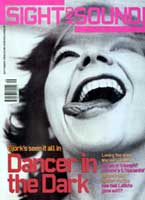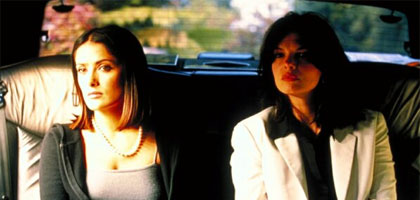Primary navigation


Mike Figgis' Timecode unfolds on four screens in real time. Xan Brooks thinks it works both as a drama and as a bold experiment in video technology.
Like a series of lights coming on in an uncurtained building, Mike Figgis' Timecode opens at quarter-strength and then builds to full illumination. With the bulk of the screen's physical space still black (though abstracted light sources occasionally streak through or flicker), a window pops up filling the upper right-hand corner. Inside, a young woman (Saffron Burrows) is recounting a dream to her therapist. Midway through their exchange, an adjacent window at the top left-hand comes alive and the viewer sees a power-dressed vixen (Jeanne Tripplehorn) storm down the steps of a Beverly Hills residence and hurriedly let down the tyre of a nearby car. And we're torn. Do we continue to eavesdrop on the low, murmurous confessional in the shrink's sanctum or switch our attention to the more nakedly subversive actions next door? Or do we attempt to keep tabs on both: snooping on the top-right square while playing peeping Tom on top-left. A moment later, two more windows of opportunity have opened up on the picture's bottom storey and we're torn again. Four frames, four narratives. A quartet of options for the discerning voyeur to choose between.
Played out on a quartered screen, in real time, with no edits, Timecode is an ongoing fascination. As an exercise in parallel plotting, it's endlessly inventive. As a filmic experiment, it's gloriously audacious. If the closing credits neglect to acknowledge an editor, that's in part because the viewer is implicitly encouraged to fill that role for him or herself: concentrating on the dramas and characters that grab his or her attention and tuning out the others. Admittedly Timecode falls some way short of attaining the Holy Grail that is the first truly interactive feature film, but it at least has its nose pointed in the right direction.
It also hits something of a high-water mark in Figgis' push towards a more formally ambitious mode of movie-making; a push that began with 1995's award-winning, low-budget Leaving Las Vegas and continued through last year's floridly experimental The Loss of Sexual Innocence. In preparing Timecode, Figgis (a keen musician) composed his film on music sheets, as though scoring a string quartet. He then proceeded to shoot the picture in one continuous 93-minute take. The film's four digital-video cameras (operated by Figgis, James O'Keeffe, Tony Cucchiari and director of photography Patrick Alexander Stewart) were all turned on simultaneously and run on a common timecode, the electronic counter encoded on the tapes. There was no formal script and the blocking was largely improvised. The dangers, of course, in such a no-nets mode of working are manifest. At one stage a tell-tale hand can be glimpsed holding open the door as we trail Salma Hayek's starlet into the washroom, while on several occasions where the narratives overlap two frames move into such close proximity that the cameras must be mere inches away from clashing. But on the whole Timecode synchronises its high-wire act with aplomb: technically, this is a virtuoso piece of work.
More crucially, the film succeeds on a dramatic level. Figgis has admitted suffering initial qualms over the viability of his split-screen, parallel-plotting device, fretting that Timecode's constant four-way dialogue of sound and visual information would swamp the viewer. He concluded, however, that a diet of channel-surfing and multi-media has made sophisticates of modern-day filmgoers, equipping them to process a bombardment of information thrown at them on various frequencies. Where MTV would sate its audience through frenzied editing, Figgis reasoned, Timecode would do so through simultaneous, real-time narratives. Formally separate, these two modes of communication are spiritual cousins. The difference is that while the dominant MTV style is traditionally accused of spoon-feeding its public, Timecode empowers them. It serves up four dishes and invites us to sample instances of drama from each one.
Undeniably this makes for a tart and appealing diet. Timecode revolves around the Hollywood offices of Red Mullet films (the name of Figgis' own production company) and juggles a roster of semi-crazed Day of the Locust types with lots of satirical potshots at the movie industry. So we get comedic script pitches ("It's like Shine except the guy has a lot more problems"), forlorn mantras ("I am always in the right place at the right time") and duff green-lit projects (a director is auditioning actresses for the star role of a girl "who's sleeping her way to the top of a public-relations firm in Missouri"). The largely improvised acting is sharp and convincing (particularly from Stellan Skarsgård and Salma Hayek) and the quartet of stories feed smartly into one another.
But while Timecode provides some measure of viewer freedom, this is finally a freedom within limits. Throughout it all, one can never quite escape the godlike hand of Figgis (credited as writer, director, producer and composer) at work behind the scenes. In structuring the film as a piece of music, its creator shrewdly allows some frames to idle while the others combust. In overseeing the sound edit (with no room for a boom, a plethora of hidden microphones were used, following techniques pioneered by Robert Altman on California Split, 1974, and Nashville, 1975), Figgis elects to keep certain tracks low down in the mix and emphasise the dialogue elsewhere.
He even throws in a mission statement. Near the end of the film, Mia Maestro pops up as Ana, a glacial teenage prodigy who wants to throw out the trusty Eisensteinian montage in favour of a new form of cinematic language. "Montage has created a false reality," she proclaims. "Digital is demanding new expressions." Her proposed film will be played out in real time, on four cameras, in one continuous take. To Ana, the proposal is revolutionary. To Skarsgård's anguished executive it sounds like "the most pretentious crap I've ever heard".
In the end Timecode is never pretentious - it's too witty, too sure-footed, too infectiously exuberant for that. But it's not quite revolutionary either. In dispensing with montage, Timecode liberates the medium up to a point, but is still constrained by the simple need (perhaps inherent in all drama) to order its material and tell a story. Ergo, Timecode's structure nudges the viewer subtly towards what Figgis regards as the important frames.
Timecode unfolds like a fantastically textured stretch of contemporary jazz. Its segmented interior is maddening, involving, often exhilarating. But there is a strict methodology behind its madness, and what sounds like free-form chaos in the opening bars soon swings into orbit around a central, unifying structure. In attempting to reconfigure the language of film, Timecode bends the rules beautifully. Yet it never quite breaks them.